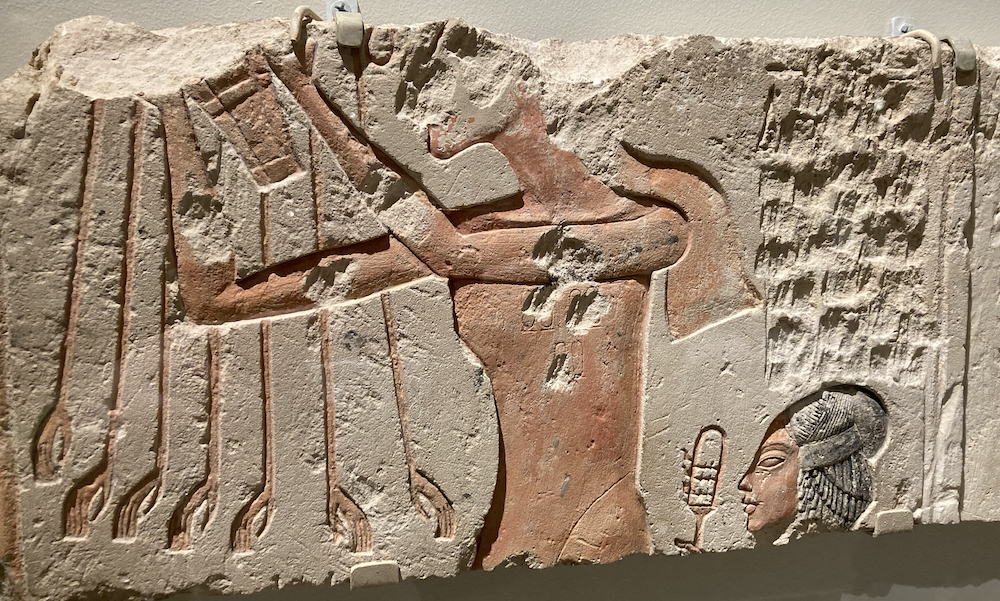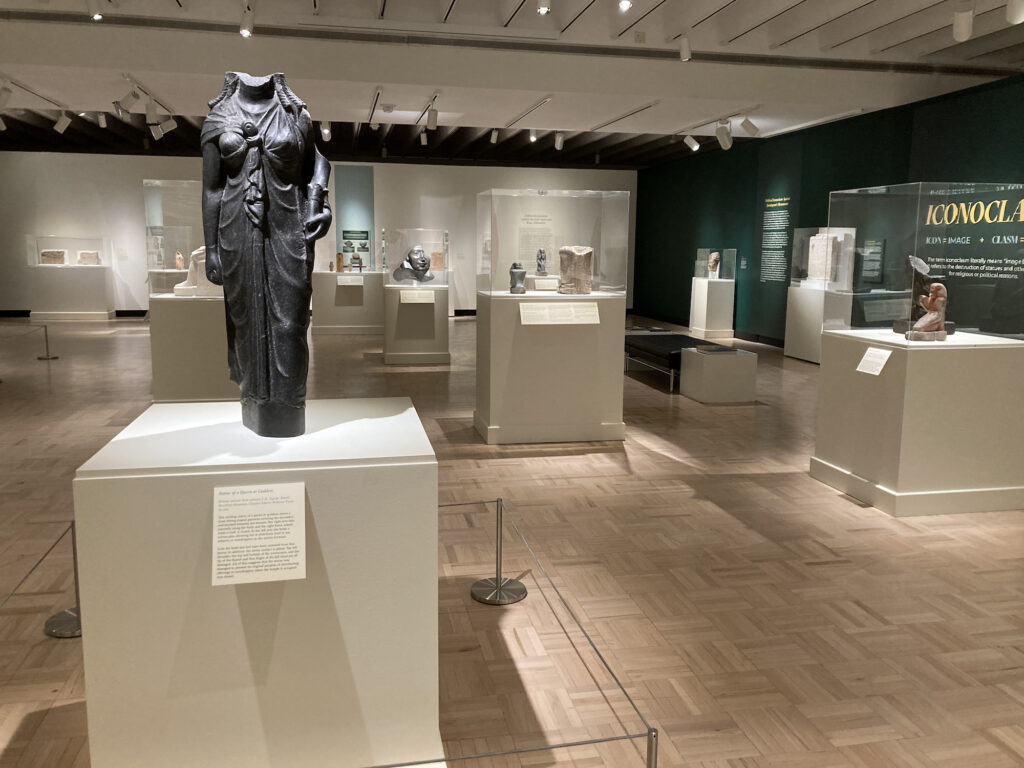Why do people feel moved to damage a piece of art? This is one of the main questions which the exhibition “Striking Power: Iconoclasm in Ancient Egypt”—now on at the Memorial Art Gallery, Rochester—tries to answer through the three dozen or so statues and reliefs it brings together. Some of these objects have been damaged, often quite badly; others are intact, there to provide a sense of what the damaged ones might once have looked like.
Ancient Egyptians believed that statues or images could be “activated” to become the hosting vessel for supernatural power—whether a deity or the soul of a dead person—and also that they could be “deactivated” by damaging key parts such as noses or hands. It must have taken at least steadfast determination, if not outright anger or fear, to undertake such a deactivation, particularly since decapitating a statue or chiselling hieroglyphs off a relief couldn’t have been the work of a mere moment.
Many of the objects in this exhibition therefore come from pivotal moments in Egyptian history, such as the reigns of Hatshepsut (ca. 1478–1458 BCE), one of the most famous women to have ruled as Pharaoh, and of Akhenaten (ca. 1353-ca. 1336 BCE), who famously but unsuccessfully tried to turn the country towards the sole worship of the sun disc Aten. After Hatshepsut’s death, familial tensions and anxieties about the legitimacy of the succession meant that subsequent rulers tried to erase her name from history. In Akhenaten’s case, images of or texts about the radical ruler were damaged in an attempt to return thoroughly and finally to the old order—and perhaps also to do damage to the dead pharaoh in the afterlife.

Not all the damage to these objects occurred during the Pharaonic period, however. Once Christians became the overwhelming majority of the population, by the Late Antique period, they attacked the sites of the old faith: a demonstration that their religion now had the upper hand and, perhaps, also a neutralizing of any malign supernatural forces which might cling to the ancient temples and to the statues and carvings which adorned them. There’s something really fascinating about how these damaged pieces show shifts and transformations of power over centuries, and how even the assertion of Christian hegemony required the tacit acknowledgement of the spiritual and supernatural power with which the objects had been imbued over many generations.
What was not addressed in the exhibition was why there was such an apparent difference in how Christians and Muslims in pre-modern Egypt responded to these objects. Both faiths have strong aniconic currents—something recently a topic of much discussion in light of the controversy created by Hamline University—yet the exhibition attributes the destruction of objects only to the former community. A statue of the kneeling prince Khaemwaset (below) was broken in two and chiselled into a roughly triangular shape. This, according to the accompanying label, was to allow the stone to be reused in new construction, and this reuse was something that often happened in medieval Egypt. In other words, this wasn’t an attempt to destroy the statue’s power so much as no one knowing or caring that it had had power in the first place.
Was this apparent difference in Christian and Muslim attitudes just the result of the passage of time? There wasn’t an overlap between the observance of Islam and of ancient Egyptian polytheism in the way that there had been between the latter and Christianity. Or was it that everything that could readily be damaged had been so by the Islamic period? Frustratingly for me, the exhibition didn’t seem to offer any theories as to this difference, or walk the visitor more carefully through the reasoning used by the curators to arrive at their conclusions.

Nor was it clear to me how we know that there was no reuse of ancient stones in Byzantine-era Egypt, or what Coptic Christian Egyptians thought about these objects during, say, the Mamluk period. Is reuse always a straightforward matter of utilitarianism, or might it be its own form of iconoclasm? Might it even sometimes be a form of respect, an incorporation of a legitimizing antiquity into a new structure? Is there even a hard-and-fast rule for distinguishing iconoclastic attacks from accidental damage?
The extent of the damage of the statue of Ptahhotep (above), and its concentration on the head and hands, would seem to indicate deliberate destruction. But the label accompanying the equally headless statue of Khaemhat (above) stated that scientific analysis had shown it had been damaged by water action over the centuries, not by human hands (It wasn’t quite clear to me on what criterion it had therefore been selected for inclusion in this exhibition). On some other objects I have to admit that I struggled to see the marks of intentional vandalism that the accompanying text told me was there. It often looked like the simple wear and tear of centuries to me. Is neglect iconoclastic?
I wanted to be convinced more than I ultimately was by the story being told here—but as I sat and looked at the display cases around me, I ended up with the feeling that some bits that didn’t fit had been chiselled away in order to create a smoother story arc.
The exhibition doesn’t make any direct modern connections, though certainly many came to mind as I made my way around it: the destruction of the Buddhas of Bamiyan by the Taliban, the long history of racist arson attacks against Black churches in the U.S., the debates over whether and which modern statues should be taken down or moved. People today may not share the beliefs of Ancient Egyptians about how some part of the divine can inhabit an object, but I think few would disagree with the idea that to take aim at a valued object is make a statement about power: who should have it, and who should not. Above all, “Striking Power” is a reminder of just how complex this issue is.

“Striking Power: Iconoclasm in Ancient Egypt” runs at the Memorial Art Gallery, Rochester, until March 5, 2023.

